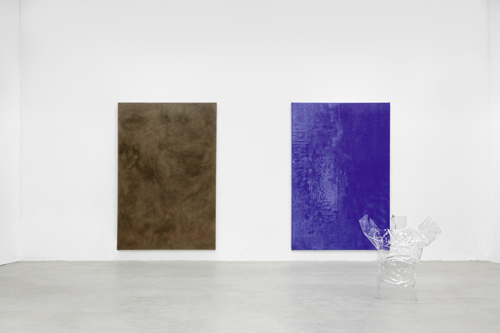Juliette Bonneviot
Plastic surgery
Plastic surgery

Of plastic, Roland Barthes wrote in 1957: ‘[M]ore than a substance, plastic is the very idea of its infinite transformation; as its everyday name indicates, it is ubiquity made visible. And it is this, in fact, which makes it a miraculous substance: a miracle is always a sudden transformation of nature.’ The quasi-religious awe of this text is hard to reconcile with the reality of environmental affairs today: consider the Pacific trash vortex, an accumulation of plastic waste in the North Pacific estimated to be the size of Texas; or the fact that it takes an ordinary water bottle 450 years to biodegrade.
It is this plasticity – between nature and artifice, permanence and disposal – which Juliette Bonneviot investigates in her sculptures and paintings. For her solo exhibition Minimal Jeune Fille (2014) at Wilkinson in London, the French-born, Berlin-based artist presented a series of sculptures mixing materials such as wood and steel with synthetic PET (polyethylene terephthalate) and HDPE (high-density polyethylene) plastics. The ‘Jeune Fille’ (‘Young-Girl’) of the exhibition’s title was a character adapted from a theoretical tract by French radical political collective Tiqqun, Preliminary Materials for a Theory of the Young-Girl (1999). In this pamphlet, the Young-Girl, expressing herself through her consumption, becomes consumer society’s total product and model citizen. Likewise, through Bonneviot’s sculptural arrangements of everyday products, synthetic materials, and humanoid figures, one could trace the outlines of an anxious consumer, albeit one who is as concerned about the environmental effect of her purchases as she is cognizant that she is inseparable from them.
The sculpture Minimal Jeune Fille. Kitchen Worktop (2013), for instance, is a two-metre wooden board mounted flush against the wall. On the board, a small HDPE jar and a wooden scrub brush are held in place by a crumpled, transparent PET plastic sheet. In Minimal Jeune Fille banc / display (2013) a glass jar sits beside a wooden toothbrush, a safety razor and a washable menstruation pad on a bench; as with Kitchen Worktop… everything is draped by a sheet of clear PET plastic. While Tiqqun states that the Young-Girl is not necessarily female, the wipe-clean and almost sterile minimalism of Bonneviot’s sculptural works allude to the disparate expectations of hygiene and beauty among genders. Bonneviot’s ‘character’ seems at pains to avoid the supposedly abject female body and all its messy connotations.

Bonneviot told me that it was after watching a documentary on the health effects of plastic use, in which an expert proposed that women have more plasticizers in their bodies because they use more cosmetics, that she first realized that to continue to distinguish between ‘natural’ and ‘unnatural’ was senseless – an insight developed for works in the group exhibition nature after nature (2014) at the Fridericianum, Kassel. But it is clear that Bonneviot is no eco-warrior; she is as fascinated about the material properties of plastic as she is perturbed by its ubiquity. With the PET Woman series (2013–ongoing) Bonneviot uses the malleability of plastic to mold the curves of female torsos with single PET plastic sheets. In Minimal Jeune Fille some of these pieces were hung on the wall, but in a more recent presentation at Autocenter (2015) in Berlin the thigh-high torsos sat directly on the floor (the ‘PET’ of the title gaining a troubling double meaning).
Elsewhere at Autocenter Bonneviot showed her newest series, XenoEstrogens (2015). At first glance these 1.80 × 1.20 m paintings look like run-of-the mill monochromes – a colour for every taste – but the materials list reveals otherwise. To create these pieces Bonneviot first compiled a list of products that contain xenoestrogen, a chemical compound that mimics the effects of estrogen. Sorted by colour, Bonneviot ground these products into a powder, mixed them with PVC and silicone and poured the results onto a linen canvas. (Linen comes from the flax plant, which produces its own naturally occurring xenohormone as a defense against herbivores.) Xenoestrogens, which have been linked to hormonal disruption and a range of reproductive abnormalities, can be found either organically or synthetically in many materials. The materials list for Yellow XenoEstrogens (2015) – shown most recently as part of the group show Looks (2015) at the ICA in London – for example, lists soya beans, antimony (‘a useful alloy with lead’), cadmium (‘used in batteries and has reportedly been found in wonton soup’) and phthalates (‘in wood floor lacquer’). XenoEstrogens explores the construction of identity without offering any neat conclusions. After all, if we risk ingesting potential hormone disruptors every time we eat wonton soup or deep-fried fast food the idea of a stable ‘self’ becomes vacuous.
What distinguishes Bonneviot from many of her contemporaries is that rather than taking a post-gender stance, her work considers how collapsing the boundary between ‘culture’ and ‘nature’ affects the still-disenfranchised female body. In this way, Bonneviot’s sculptures and paintings explore the darker side of what Barthes called man’s ‘prestigious free-wheeling through nature’.

























